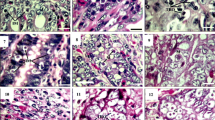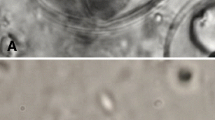Abstract
The infectivity ofCryptosporidium muris (strain RN 66), originally isolated from the house rat (Iseki 1986), to various laboratory animals was studied by transmission experiments. After oral inoculation with 1×106 oocysts, mice, guinea pigs, rabbits, dogs, and cats all discharged endogenously produced oocysts in their feces. Among these host species, mice and cats were highly susceptible to the parasite. The prepatent period for six 3-week-old specific pathogen-free (SPF) mice was 5 days postinoculation (PI), the patent periods varied between 34 and 75 days for each mouse, and the number of oocysts discharged per individual per day (OPD) was 11–46×106 at the maximum on days 16–26 PI. The total number of oocysts discharged per mouse during the patent period was estimated to be 170–560×106. Three inoculated cats (1–2 months old) also discharged a large number of oocysts for a long period. Guinea pigs, rabbits, and dogs showed low susceptibility to this strain; the OPD was extremely small and the patent periods were less than 3 weeks. The entire endogenous development of this parasite occurred in the stomach and not in the small and large intestines of these experimental animals. Because of this lack of host specificity, it is suspected thatC. muris could be infective to humans, especially immunocompromised patients such as those with AIDS.
Similar content being viewed by others
References
Iseki M (1979)Cryptosporidium felis sp.n. (Protozoa: Eimeriorina) from the domestic cat. Jpn J Parasitol 28:285–307
Iseki M (1986) Two species ofCryptosporidium naturally infecting house rats,Rattus norvegicus. Jpn J Parasitol 35:521–526
Levine ND (1984) Taxonomy and review of the coccidian genusCryptosporidium (Protozoa, Apicomplexa). J Protozool 31:94–98
Tyzzer EE (1907) A protozoan found in the peptic glands of the common mouse. Proc Soc Exp Biol Med 5:13–13
Tyzzer EE (1910) An extracellular coccidiumCryptosporidium muris (gen. et sp. nov.) of the gastric glands of the common mouse. J Med Res 23:487–509
Tyzzer EE (1912)Cryptosporidium parvum (sp. nov.) a coccidium found in the small intestine of the common mouse. Arch Protistenkd 26:349–412
Tzipori S, Angus KW, Campbell I, Gray EW (1980)Cryptosporidium: evidence for a single species genus. Infect Immun 30:884–886
Uni S, Iseki M, Maekawa T, Moriya K, Takada S (1987) Ultrastructure ofCryptosporidium muris (strain RN 66) parasitizing the murine stomach. Parasitol Res 74:123–132
Upton SJ, Current WL (1985) The species ofCryptosporidium (Apicomplexa: Cryptosporidiidae) infecting mamals. J Parasitol 71:625–629
Vetterling JM, Jervis HR, Merril TG, Sprinz H (1971)Cryptosporidium wrairi sp. n. from the guinea pgiCavia porcellus with an emendation of the genus. J Protozool 18:243–247
Author information
Authors and Affiliations
Rights and permissions
About this article
Cite this article
Iseki, M., Maekawa, T., Moriya, K. et al. Infectivity ofCryptosporidium muris (strain RN 66) in various laboratory animals. Parasitol Res 75, 218–222 (1989). https://doi.org/10.1007/BF00931279
Accepted:
Issue Date:
DOI: https://doi.org/10.1007/BF00931279




